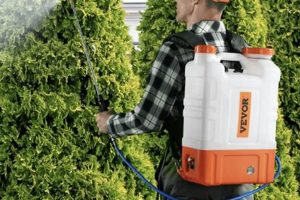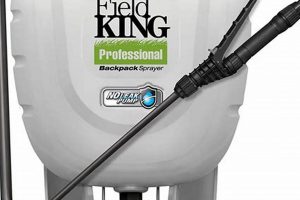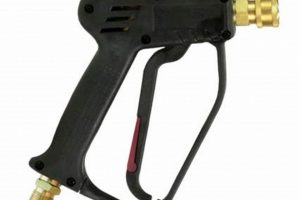This equipment serves as a portable solution for dispensing liquids, primarily herbicides, pesticides, and fertilizers, over a defined area. These units typically feature a tank worn on the operator’s back, a pump mechanism to generate pressure, and a wand with a nozzle for directing the spray. They are commonly utilized in agricultural, landscaping, and property maintenance applications. As an example, a homeowner might employ one to control weeds in a garden or apply insecticide to shrubs.
Such devices offer advantages in terms of mobility and targeted application compared to larger, more cumbersome sprayers. They allow for precise control of the dispensed liquid, minimizing waste and reducing the risk of overspray onto non-target areas. Historically, manual pump sprayers have evolved from simple bellows-driven models to more sophisticated designs incorporating features like pressure regulators and adjustable nozzles. Their use has significantly increased efficiency and effectiveness in various spraying tasks.
The following sections will delve into specific aspects, including the selection criteria, operational considerations, maintenance procedures, and potential safety hazards associated with using this type of spraying apparatus.
Operating Considerations
Optimal performance and longevity of the spraying equipment necessitate adherence to specific operational guidelines. Improper usage can lead to reduced efficacy and potential equipment damage.
Tip 1: Calibration is Paramount. Prior to commencing any spraying operation, calibrate the unit to ensure the correct application rate. This involves measuring the output volume over a given time period and adjusting the nozzle or pressure accordingly. Over-application can lead to chemical waste and environmental concerns; under-application may render the treatment ineffective.
Tip 2: Fluid Viscosity Matters. The viscosity of the fluid being sprayed will influence the nozzle selection and pressure requirements. Thicker liquids, such as some herbicides, may necessitate a wider nozzle orifice and higher pump pressure to achieve proper atomization. Consult the chemical manufacturer’s recommendations for specific guidance.
Tip 3: Nozzle Selection Impacts Coverage. Different nozzle types produce varying spray patterns, including cone, fan, and stream. The choice of nozzle should align with the target application. For instance, a fan nozzle is suitable for broad coverage, whereas a cone nozzle may be preferable for spot treatments.
Tip 4: Maintain Consistent Pressure. Consistent pressure is crucial for uniform spray distribution. Variations in pump speed or battery charge (in electric models) can lead to inconsistent application. Regular monitoring and adjustment of the pressure setting are therefore essential.
Tip 5: Environmental Conditions Influence Effectiveness. Wind speed, temperature, and humidity can all impact the effectiveness of the spraying operation. Avoid spraying during periods of high wind, as drift can carry chemicals to unintended areas. High temperatures can cause excessive evaporation, reducing the amount of chemical reaching the target. Humidity can influence the absorption rate of certain chemicals.
Tip 6: Cleanliness Prevents Clogging. Regular cleaning of the tank, filter, and nozzle is essential to prevent clogging and maintain optimal performance. Residue buildup can impede flow and compromise the spray pattern. Flush the system with clean water after each use and periodically disassemble the nozzle for thorough cleaning.
Implementing these procedures will contribute to enhanced spraying efficacy, reduced chemical waste, and extended equipment lifespan. Careful attention to these details translates directly into a more effective and environmentally responsible spraying program.
The next section addresses the importance of proper equipment maintenance, emphasizing practices that prolong the life and operational effectiveness.
1. Capacity
Tank capacity represents a fundamental characteristic dictating the operational scope and efficiency of the spraying device. It directly influences the duration a user can continuously spray before requiring a refill, thereby affecting productivity and suitability for different tasks.
- Operational Range and Efficiency
A larger tank capacity allows for extended operation without interruption, proving advantageous for treating expansive areas. Conversely, a smaller tank reduces overall weight and may be preferable for spot treatments or navigating confined spaces. The selection should align with the typical size of the treatment area and the nature of the spraying task.
- Fluid Weight and User Fatigue
The weight of the fluid contained within the tank significantly contributes to user fatigue. A fully loaded sprayer can weigh upwards of 50 pounds, placing considerable strain on the operator’s back and shoulders. Therefore, balancing capacity with user comfort is crucial, particularly for prolonged use. Consider lighter materials and ergonomic designs to mitigate strain.
- Chemical Concentration and Mixing Ratios
Tank capacity influences the quantity of concentrated chemicals required to achieve the desired solution strength. Accurate measurement and mixing are essential to ensure effective treatment without exceeding recommended application rates. Precise calculations are necessary to maintain consistent chemical concentrations throughout the spraying process, regardless of tank size.
- Storage and Transportation Considerations
The physical dimensions of the tank, determined by its capacity, impact storage and transportation requirements. Larger units may necessitate dedicated storage space and specialized handling equipment. Consider the ease of filling, emptying, and cleaning the tank, as these aspects contribute to overall operational convenience.
In summation, tank capacity is a critical parameter influencing the practicality and efficiency. A thorough assessment of the intended applications and user capabilities is necessary to select an appropriately sized unit that optimizes performance and minimizes operational challenges.
2. Pump Type
The pump mechanism is a central component determining the operational effectiveness of any spraying equipment. The design and functionality of this mechanism directly influence the pressure, flow rate, and overall consistency of the spray output. In the context of the apparatus, understanding the available pump types and their respective characteristics is crucial for selecting a unit that aligns with specific application requirements.
- Manual Piston Pumps
Manual piston pumps rely on the operator’s physical exertion to generate pressure. A lever or handle is repeatedly actuated, drawing liquid into a cylinder and then forcing it out through the nozzle. While generally less expensive and mechanically simpler, these pumps require continuous effort, potentially leading to operator fatigue during prolonged use. They are often suitable for smaller-scale applications and intermittent spraying tasks.
- Diaphragm Pumps
Diaphragm pumps utilize a flexible diaphragm that moves back and forth to displace liquid. These pumps offer increased resistance to abrasive or corrosive chemicals compared to piston pumps, as the liquid does not come into direct contact with the pump’s internal components. They are commonly found in units designed for handling a wider range of chemical formulations.
- Electric Pumps (Battery-Powered)
Electric pumps employ a battery-powered motor to drive the pumping mechanism, eliminating the need for manual operation. This results in a more consistent spray pressure and reduces operator fatigue. Battery life and pump performance are key considerations when evaluating electric models. Some units feature adjustable pressure settings and variable flow rates for enhanced control.
- 12V Diaphragm Pumps
12V diaphragm pumps provide a higher pressure than manual and other battery powered backpack sprayers. It is suitable for large applications that need stronger pressure for long distance.
The selection of an appropriate pump type involves a careful evaluation of factors such as application frequency, chemical compatibility, desired spray pressure, and operator comfort. While manual pumps offer a cost-effective solution for occasional use, electric pumps provide increased convenience and efficiency for more demanding applications. Consideration of these factors is essential for maximizing the utility and lifespan of the spraying apparatus.
3. Nozzle Variety
The availability of diverse nozzle types constitutes a critical factor in the operational versatility of a spraying apparatus. Nozzle selection directly influences spray pattern, droplet size, and flow rate, thereby affecting the efficacy and efficiency of chemical application. A limited selection restricts the sprayer’s utility to specific tasks, whereas a broad range of options allows for adaptation to varying conditions and application requirements. For instance, a flat fan nozzle is suitable for uniform coverage of broad surfaces, while a cone nozzle delivers a more concentrated spray for spot treatments. The presence of adjustable nozzles further enhances adaptability, allowing operators to modify spray parameters on demand.
The correlation between nozzle variety and the practical application of a spraying device becomes evident in diverse scenarios. Consider a landscaper tasked with both applying herbicide to expansive lawns and precisely targeting weeds in flowerbeds. A single nozzle type would prove inadequate for both tasks, potentially resulting in wasted chemicals or damage to desirable plants. However, a sprayer equipped with interchangeable nozzles enables the landscaper to select the optimal spray pattern and droplet size for each specific application, maximizing efficiency and minimizing collateral damage. This versatility translates to cost savings, reduced environmental impact, and improved overall results.
In conclusion, nozzle variety is not merely an ancillary feature, but an integral determinant of a spraying device’s performance and adaptability. The capacity to tailor spray characteristics to specific applications significantly enhances the sprayer’s utility, contributing to improved efficiency, reduced chemical waste, and enhanced control over the treatment process. The limitations imposed by a restricted nozzle selection can ultimately compromise the effectiveness and value of the entire apparatus, underscoring the importance of considering nozzle variety when evaluating a spraying device.
4. Pressure Control
Consistent and adjustable pressure regulation is a critical attribute that directly influences the effectiveness and uniformity of applications performed by a spraying device. In the context of this portable spraying equipment, the ability to manage pressure levels facilitates precise control over spray patterns, droplet size, and flow rates, ultimately impacting the efficiency of chemical dispersal and minimizing potential waste.
- Uniform Application and Coverage
Stable pressure ensures consistent spray output, leading to uniform coverage across the target area. Fluctuations in pressure can result in uneven application, with some areas receiving excessive amounts of the treatment solution while others receive insufficient amounts. This consistency is paramount for herbicides, pesticides, and fertilizers to be effective. Consider a scenario where inconsistent pressure leads to patchy weed control or uneven fertilization, negatively affecting the intended outcome.
- Droplet Size and Drift Mitigation
Pressure directly affects the size of the droplets produced by the nozzle. Higher pressure typically results in smaller droplets, which are more prone to drift due to wind. Conversely, lower pressure generates larger droplets that are less susceptible to drift but may not provide adequate coverage. The ability to adjust pressure allows the operator to optimize droplet size based on environmental conditions, minimizing off-target spray and maximizing chemical deposition on the intended target.
- Nozzle Performance and Clogging Prevention
Maintaining appropriate pressure is crucial for optimal nozzle performance. Insufficient pressure can lead to poor atomization and incomplete spray patterns, while excessive pressure can damage the nozzle or cause premature wear. Additionally, consistent pressure helps to prevent nozzle clogging by ensuring a steady flow of liquid and minimizing the accumulation of particulate matter. Regular monitoring and adjustment of pressure are essential for maintaining nozzle functionality and extending its lifespan.
- Chemical Compatibility and System Integrity
Different chemicals may require specific pressure ranges for optimal application and to prevent damage to the spraying equipment. Some chemicals may become unstable or corrosive at higher pressures, while others may require higher pressures to achieve proper atomization. The ability to control pressure ensures compatibility with a wider range of chemical formulations and minimizes the risk of equipment failure or chemical incompatibility issues. Adhering to manufacturer’s recommendations regarding pressure settings for specific chemicals is crucial for safe and effective operation.
The facets of pressure control emphasize its role in maximizing the efficacy, safety, and longevity of these spraying devices. By enabling precise manipulation of spray characteristics, pressure regulation empowers operators to optimize chemical application, minimize environmental impact, and ensure consistent results across a range of applications. The absence of effective pressure control compromises the entire spraying operation.
5. Material Durability
Material durability is a paramount consideration in the selection and utilization of spraying apparatus. The inherent resistance of the components to degradation from chemical exposure, environmental factors, and mechanical stress directly impacts the lifespan, performance, and overall cost-effectiveness of the equipment.
- Tank Construction and Chemical Resistance
The tank, as the primary reservoir for chemical solutions, requires robust construction using materials resistant to corrosion, degradation, and permeation. Polyethylene and polypropylene are commonly employed due to their inherent chemical inertness and impact resistance. However, prolonged exposure to certain aggressive chemicals may still lead to embrittlement or structural failure. For instance, repeated use with strong solvents could compromise a tank not specifically designed for such applications, resulting in leaks and potential environmental contamination. Therefore, material selection is vital for chemical compatibility.
- Pump Components and Abrasive Wear
The pump mechanism, responsible for generating and maintaining pressure, is subject to constant mechanical stress and exposure to abrasive particles within the spray solution. Components such as pistons, diaphragms, and seals must exhibit high wear resistance to ensure reliable operation. Materials such as stainless steel, reinforced polymers, and specialized elastomers are often utilized to withstand these demanding conditions. Inadequate material selection can lead to premature pump failure, necessitating costly repairs or replacements.
- Wand and Nozzle Integrity
The wand and nozzle assembly, responsible for directing and atomizing the spray solution, are vulnerable to physical damage and chemical attack. The wand material must possess sufficient rigidity to withstand bending and breakage, while the nozzle material must resist corrosion and erosion from abrasive chemicals. Brass, stainless steel, and hardened plastics are commonly used for nozzle construction. Regular inspection and replacement of worn or damaged nozzles are essential for maintaining spray pattern accuracy and preventing leaks.
- Frame and Support Structure Corrosion
The frame and support structure, which bear the weight of the tank and internal components, must resist corrosion from moisture, chemicals, and environmental exposure. Steel frames are often coated with protective finishes such as powder coating or galvanization to enhance their corrosion resistance. Plastic frames offer inherent resistance to corrosion but may be less durable under heavy loads. The structural integrity of the frame is critical for ensuring the stability and safe operation of the spraying device.
These material considerations collectively determine the operational lifespan and reliability of the spraying equipment. Investing in a unit constructed from durable, chemically resistant materials translates to reduced maintenance costs, minimized downtime, and enhanced safety. Careful evaluation of material specifications is essential for selecting a spraying apparatus that can withstand the rigors of demanding applications and provide long-term value.
6. Weight Distribution
Effective weight distribution is a critical design element in the practical application of spraying apparatus. It directly influences operator comfort, reduces fatigue, and enhances overall maneuverability during extended use. An imbalanced unit can lead to musculoskeletal strain and decreased productivity, particularly in demanding operational environments.
- Center of Gravity and Stability
The center of gravity’s placement significantly impacts stability. A high center of gravity, often resulting from a full tank positioned high on the back, increases the risk of imbalance and tipping, especially on uneven terrain. Conversely, a lower center of gravity enhances stability but may compromise accessibility for filling and cleaning. Design considerations strive to optimize this balance for both safety and usability. For example, contoured tank designs and adjustable harness systems aim to lower the center of gravity and distribute the load more evenly across the operator’s back.
- Harness System and Load Transfer
The harness system is crucial for transferring the weight of the sprayer from the shoulders and back to the hips and legs. A well-designed harness incorporates padded shoulder straps, an adjustable chest strap, and a supportive waist belt. These features distribute the load across a larger surface area, reducing pressure points and minimizing strain. Insufficient padding or poorly adjusted straps can lead to discomfort, fatigue, and potential injury. High-quality harness systems enable users to work comfortably for extended periods, enhancing productivity and reducing the risk of musculoskeletal issues.
- Tank Shape and Fluid Dynamics
The shape of the tank influences fluid dynamics and weight distribution during operation. A tank with internal baffles minimizes sloshing, which can cause sudden shifts in weight and disrupt balance. A wide, flat tank design distributes the weight more evenly across the back, reducing concentrated pressure points. Conversely, a narrow, tall tank concentrates the weight in a smaller area, potentially leading to discomfort and fatigue. Tank design plays a critical role in optimizing weight distribution and minimizing the dynamic effects of fluid movement.
- Material Selection and Overall Weight
The materials used in construction contribute significantly to the overall weight of the sprayer, which in turn affects weight distribution. Lightweight materials, such as high-density polyethylene, reduce the total load, minimizing strain on the operator. However, these materials must also possess sufficient strength and durability to withstand the rigors of demanding applications. Balancing weight reduction with structural integrity is a key consideration in the design and material selection process. Lighter units enhance maneuverability and reduce fatigue, promoting greater efficiency and safety.
These interlinked factors contribute to the overall ergonomic design and usability of this spraying equipment. Optimizing these aspects is essential for maximizing operator comfort, reducing fatigue, and enhancing productivity during spraying operations. Manufacturers should prioritize these considerations to ensure that the sprayer is not only effective but also comfortable and safe to use for extended periods.
7. Seal Integrity
Seal integrity is a critical performance parameter for a portable spraying apparatus. This parameter refers to the ability of various seals within the unit to prevent leakage of the contained liquids. Failure of these seals can result in chemical exposure to the operator, environmental contamination, and reduced spraying efficiency due to pressure loss. Real-world examples include herbicide leakage onto the operator’s clothing, pesticide runoff into water sources, and diminished spray range because of pump inefficiency. Given the potential hazards and inefficiencies, the integrity of these seals directly affects both safety and performance.
The materials used in seal construction, the design of the sealing surfaces, and the operating pressures within the system all contribute to seal integrity. For instance, using an incompatible seal material for a specific chemical can lead to premature degradation and failure. Similarly, improperly designed seals or excessive operating pressures can cause leaks. Regular inspection and maintenance, including replacing worn or damaged seals, are necessary to ensure continued leak-free operation. Understanding these factors is crucial for operators to prevent accidents, minimize environmental impact, and maintain optimal sprayer performance.
In summary, seal integrity is not merely a desirable feature but an essential requirement for a safe, efficient, and environmentally responsible. Its maintenance is a shared responsibility involving careful material selection, proper operation, and diligent inspection and upkeep. Ignoring this can lead to considerable consequences.
Frequently Asked Questions About Spraying Apparatus
The following section addresses common inquiries regarding spraying equipment, aiming to provide clarity on operational aspects, maintenance procedures, and safety considerations.
Question 1: What is the recommended procedure for calibrating this equipment?
Calibration involves measuring the sprayer’s output volume over a defined period and adjusting the nozzle or pressure to achieve the desired application rate. This process ensures accurate chemical dispersal and prevents over- or under-application, both of which can compromise treatment effectiveness.
Question 2: How often should the spraying device be cleaned?
Cleaning should occur after each use to prevent chemical residue buildup and nozzle clogging. The tank, filter, and nozzle should be thoroughly rinsed with clean water. Periodically, a more comprehensive cleaning involving disassembly of the nozzle may be necessary to remove stubborn deposits.
Question 3: What safety precautions should be observed when operating the spraying equipment?
Adherence to safety guidelines is essential to minimize the risk of chemical exposure and injury. Appropriate personal protective equipment (PPE), including gloves, eye protection, and respiratory protection, should be worn at all times. Avoid spraying in windy conditions to prevent drift, and never eat, drink, or smoke while operating the sprayer. Consult the chemical manufacturer’s safety data sheet (SDS) for specific handling instructions.
Question 4: What is the expected lifespan of the typical unit?
The lifespan of spraying equipment varies depending on factors such as usage frequency, maintenance practices, and the corrosiveness of the chemicals used. With proper care and maintenance, a unit can reasonably be expected to last for several years. However, components such as seals, nozzles, and pumps may require periodic replacement due to wear and tear.
Question 5: What type of chemicals are compatible with this equipment?
Chemical compatibility depends on the materials used in the sprayer’s construction. Polyethylene and polypropylene tanks are generally resistant to a wide range of chemicals, but certain solvents and corrosive substances may cause degradation. Consult the manufacturer’s specifications or the chemical manufacturer’s SDS to ensure compatibility before use. Failure to do so can result in equipment damage and potential hazards.
Question 6: How should the spraying apparatus be stored when not in use?
Proper storage is crucial for preserving the equipment’s condition and preventing chemical spills. The tank should be emptied and thoroughly cleaned before storage. Store the sprayer in a cool, dry, and well-ventilated area away from direct sunlight and extreme temperatures. Ensure that the nozzle is protected from damage and that all components are properly secured to prevent accidental spills or leaks.
These frequently asked questions offer a general overview of commonly encountered issues related to the spraying apparatus. Careful attention to these aspects will contribute to enhanced safety, efficiency, and equipment longevity.
The subsequent section provides guidelines for selecting the optimal unit based on specific needs and operational parameters.
Conclusion
The preceding sections have comprehensively explored the various facets of the tractor supply backpack sprayer, encompassing operational considerations, maintenance procedures, critical features, and frequently asked questions. Emphasis has been placed on the importance of understanding equipment capabilities, adhering to safety protocols, and selecting a unit appropriate for specific application requirements. Failure to consider these factors can result in diminished spraying efficacy, increased risk of chemical exposure, and premature equipment failure.
Therefore, informed decision-making regarding the selection, operation, and maintenance of a tractor supply backpack sprayer is paramount for achieving optimal results and ensuring operator safety. Continued adherence to best practices and a commitment to ongoing education will maximize the value and utility of this essential tool across a variety of applications. Users are encouraged to prioritize safety and environmental responsibility in all spraying operations.



![Buy Ace Hardware Backpack Sprayers Now! [Deals] Ultimate Backpack Traveler Guide: Tips, Destinations & Budget Hacks Buy Ace Hardware Backpack Sprayers Now! [Deals] | Ultimate Backpack Traveler Guide: Tips, Destinations & Budget Hacks](https://backpack-traveler.com/wp-content/uploads/2025/11/th-7-300x200.jpg)



